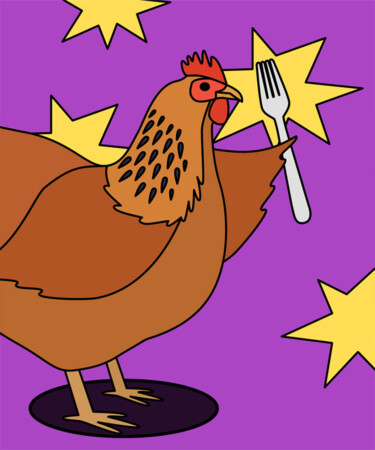This article is part of our Cocktail Chatter series, where we dive into the wild, weird, and wondrous corners of history to share over a cocktail and impress your friends.
If you’ve ever wandered through the poultry section of the grocery store and wondered when the f*ck chickens got so massive, you’re not alone. You’re also not mistaken — they have gotten bigger. The birds that wind up in supermarkets today are roughly four times larger than they were just a few decades ago with some breeds, like the Jersey Giant, capable of growing up to 15 pounds. Most Americans assume these modern-day chickens are pumped up with hormones or steroids, but the United States Department of Agriculture (USDA) has actually banned all use of both substances since the 1950s. Instead, the reason for the enlarged birds we eat today is much more natural and can be traced back to one competition held in the 1940s.
Kickstarted in 1946, the Chicken of Tomorrow Contest was intended to stimulate demand for the poultry by challenging farmers to breed a bigger, better chicken able to feed an entire family at a low cost. Before World War II, chickens were the preferred protein choice for many Americans thanks to their ability to provide both eggs and meat. Popularity remained high during the war as well, compounded by the fact that, unlike red meat, it was never rationed. But as wartime restrictions lifted, Americans gravitated to meat options like pork and beef for their lower costs and bigger portions.
Taking note of slumping demand, Howard C. Pierce, poultry research director for A&P supermarkets, argued that the chicken industry needed to put forth meatier birds with bigger breasts if it were to survive. Just a short while later, the Chicken of Tomorrow Contest — organized by the USDA and sponsored by A&P — was underway.
The competition was open to any farmer who wished to compete, each of whom was granted one year to breed a bird that was not only large but also able to reproduce. Considering crossbred chickens often fall ill or don’t breed successfully, this “chicken of tomorrow” needed to remain healthy and be able to carry on a strong line. Hundreds of farmers participated in the competition, which began with statewide contests in 1946. Winners then progressed to a regional round held the following year, with the national competition hosted in Maryland in 1948. In total, just 40 breeders and six alternates across 25 states produced chickens worthy of national judgment and only eight of those chickens were crossbred.
Each finalist was required to ship 720 eggs from their farms to a hatchery in Maryland where they lived in incubators until the chicks hatched. From there, 410 chicks from each breeder were chosen at random and raised on a standard diet in controlled conditions for 12 weeks and two days before they were killed, de-feathered, and weighed. Judges then analyzed each farmer’s chicken based on over a dozen factors ranging from skin color and mass to how quickly the bird was able to transform food into muscle.
In the end, it was a crossbred New Hampshire and Cornish chicken raised by Californian Charles Vantress that was crowned the Chicken of Tomorrow. In second place was a purebred Arbor Acres White Rock chicken bred by Connecticut farmer Henry Saglio, which would go on to be bred with Vantress’s prize bird.
The competition, and Vandress’s bird, would end up revolutionizing the nation’s poultry landscape. The winning farmer’s grasp on genetics and knack for selective breeding provided the industry with a tremendous amount of knowledge, and by the 1970s, breeders across the country had intricate family trees for each bird in their coops. By the 1980s, demand for chicken was up again, spurred by the invention of the chicken nugget and a 1977 Senate report endorsing poultry.
Since the ‘80s, demand has continued to climb year after year, with Americans now consuming roughly 101 pounds of chicken per person every year. So while the size of today’s chickens might be befuddling to some, their giant statures have solidified the poultry’s presence on dinner tables nationwide. And hey, who knows how large the next chickens of tomorrow might be?
*Image retrieved from davit85 via stock.adobe.com
